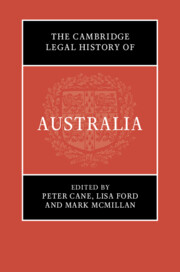Book contents
- The Cambridge Legal History of Australia
- The Cambridge Legal History of Australia
- Copyright page
- Contents
- Figures
- Maps
- Contributors
- Maps
- 1 Editors’ Introduction
- I Cultures of Law
- II Public Authority
- III Public Authorities in Encounter
- 10 The Challenge of Indigenous Polities
- 11 Australia as Empire
- 12 Australia and the World
- IV Land and Environment
- V Social Organisation
- VI Social Ordering
- VII Reckonings
- Index
11 - Australia as Empire
from III - Public Authorities in Encounter
Published online by Cambridge University Press: 04 August 2022
- The Cambridge Legal History of Australia
- The Cambridge Legal History of Australia
- Copyright page
- Contents
- Figures
- Maps
- Contributors
- Maps
- 1 Editors’ Introduction
- I Cultures of Law
- II Public Authority
- III Public Authorities in Encounter
- 10 The Challenge of Indigenous Polities
- 11 Australia as Empire
- 12 Australia and the World
- IV Land and Environment
- V Social Organisation
- VI Social Ordering
- VII Reckonings
- Index
Summary
Australia is a product and an agent of empire. From the mid-nineteenth century, the Australian colonies experimented with ‘sub-imperialism’, an expansionist project obstructed by the fact that the ‘self-governing’ white settler colonies of the British empire lacked external sovereignty. This chapter begins with the Australian colonies’ interdependence with and aspirations to annex ‘adjacent islands’ in the mid-nineteenth century. It follows the construction and administration of a Pacific empire beginning with the annexation of the Territory of Papua, to the administration of New Guinea and Nauru as League of Nations C Mandates and then as United Nations Trust Territories. Law proved an indispensable tool of Australian empire-building, producing complex relations of economic and cultural domination and resistance in Papua, New Guinea and Nauru. Amid the significant re-alignments produced by World War II, Australia attempted to renovate its empire in order to retain it. A professionalised administration of Australia’s territories and the regulation of legal citizenship were met with increasing Indigenous resistance and activism for real self-determination. Although decolonization in the later twentieth century brought Australian empire to an official end, the legacies of those expansionist aspirations continue to shape the Commonwealth’s legal, political and economic relationships with islands and communities in the Pacific region.
Keywords
- Type
- Chapter
- Information
- The Cambridge Legal History of Australia , pp. 258 - 280Publisher: Cambridge University PressPrint publication year: 2022



